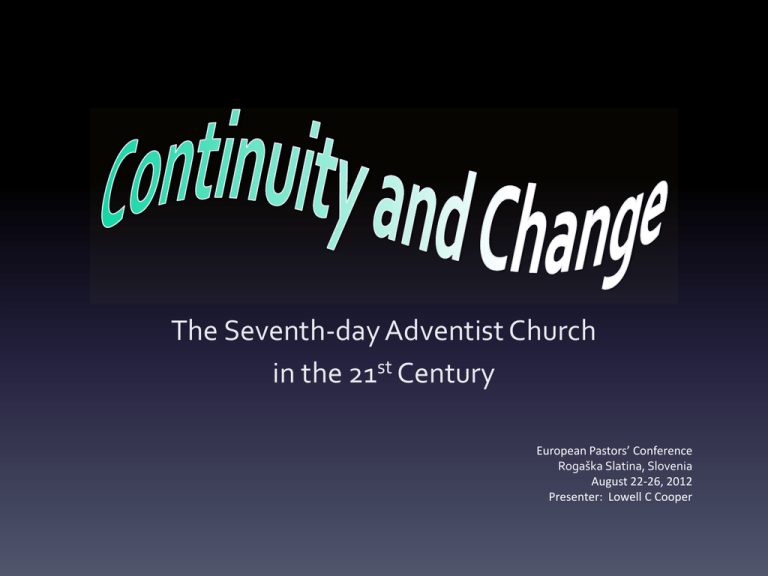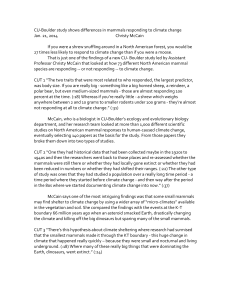Continuity and Change - Trans-European Division of the Seventh
advertisement

The Seventh-day Adventist Church in the 21st Century European Pastors’ Conference Rogaška Slatina, Slovenia August 22-26, 2012 Presenter: Lowell C Cooper Change is inevitable. We can fight it, rebel against it, pretend it doesn’t exist, hide from it, curse it, cry to God against it. But there will always be change… Do not conform to the pattern of this world, but be transformed by the renewing of your mind. Then you will be able to test and approve what God’s will is—his good, pleasing and perfect will. —Romans 12:2 “…I press on to take hold of that for which Christ Jesus took hold of me…I do not consider myself yet to have taken hold of it. But one thing I do: Forgetting what is behind and straining toward what is ahead, I press on toward the goal to win the prize for which God has called me heavenward in Christ Jesus. —Philippians 3:12-14 Continuity factors • Mission “To make disciples of all people, communicating the everlasting gospel in the context of the three angels’ messages of Revelation 14:6-12, leading them to accept Jesus as personal Savior and unite with His remnant Church, discipling them to serve Him as Lord, and preparing them for His soon return. “ Continuity factors • Mission • Vision “…the restoration of all His creation to full harmony with His perfect will and righteousness.” Continuity factors • • • • • • Mission Vision Bible as foundation for belief and practice Ministry of Ellen White as a prophet Relatively stable organizational structure Relatively unchanged polity SDA Church polity Congregational Hierarchical Interdependent “People do not mind change… they just mind being changed.” Types of organizational change: 1. Incremental change – Almost imperceptible because it happens slowly – Gentle and decentralized adaptation – Produces a broad and lasting shift – Less sense of upheaval and thus low resistance Types of organizational change: 2. Drastic/involuntary change – Often forced on an organization by circumstance or leadership, in the wake of technology, resource, or regulatory environment – Happens quickly—often involves pain, confusion, resentment and upheaval Change--Internal 1. Membership growth 1. Membership growth 1960 1,245,125 17,214,683 2011 1. Membership growth 1960 1,245,125 17,214,683 2011 Change--Internal 1. Membership growth 2. Membership distribution 2. Membership distribution--1960 Latin America 20% Oceania 4% Africa 20% Asia 13% North America 27% Europe 16% 2. Membership distribution--2011 Oceania 3% Africa 37% Latin America 32% North America 7% Europe 2% Asia 19% Change--Internal 1. Membership growth 2. Membership distribution 3. Resources—financial and human 3. World Resources--Tithe 2,500 2,000 1,500 1,000 38% 62% 40% 42% 43% 60% 58% 57% 46% 50% 54% 50% 53% 46% 47% 44% 500 0 2001 2002 2003 2004 2005 2006 2007 2008 2009 2010 2011 North America Other Divisions 3. World Resources • Relative size of the GC budget—decreased • Nationals in leadership almost everywhere • Need for personnel with international exp. Change--Internal 1. 2. 3. 4. Membership growth Membership distribution Resources—financial and human Global infrastructure 4. Global infrastructure Church members 17,214,683 Churches 71,048 Companies 65,553 Local conferences 321 Local missions 264 Union conferences 51 Union missions 55 Unions of churches 13 Divisions 13 Countries with SDA presence 209 Change--Internal 1. 2. 3. 4. 5. Membership growth Membership distribution Resources—financial and human Global infrastructure Empowerment of laity 5. Empowerment of laity • Independent initiative • Coalition of resources • Hold leaders accountable Change--Internal 1. 2. 3. 4. 5. Membership growth Membership distribution Resources—financial and human Global infrastructure Empowerment of laity Change--External 1. 2. 3. 4. 5. 6. Mission context: cultural and social Technology Economy Political Leadership climate Role of religion in society “The truths of the Judaic-Christian tradition are infinitely precious, not only, as I believe, because they are true, but also because they provide the moral impulse which alone can lead to that peace...for which we all long.... There is little hope for democracy if hearts of men and women in democratic societies cannot be touched by a call to something greater than themselves. Political structures, state institutions, collective ideals are not enough. We parliamentarians can legislate for the rule of law. You the church can teach the life of faith.” —Prime Minister Margaret Thatcher in an Address to the General Assembly of the Church of Scotland. Facing change together 1. Theological convictions based on Bible “called to global task” “called to unity and community” 2. Local and global sense of identity 3. Global name and logo (registered/use protected) 4. Shared foundations (doctrines, Church Manual, policies) 5. Shared resources (“Together we can do more”) 6. Global media (SSBSG, Adventist World, Hope Channel) 7. Global business meeting (GC Session) Finding the comfort zone: When an organization figures out what works it is tempted to become fixated on that. Unless an organization encourages regular and thorough internal challenge it is unlikely to keep up with the changing world. Persistent questioning, inquiry, is essential for remaining current. Strategies for managing change: 1. Visualize a bright future. • • • • Leaders often rush too quickly to the mechanics of change without investing the effort to create an appetite for change. Create a clear tomorrow—but do not denigrate the past. Build a belief that “we can do better” Engage people’s emotions. When you become inspired and excited about the change your influence begins to work in others. Strategies for managing change: 2. 3. 4. 5. Make a convincing case. Set up team and charter expectations Review the current state Educate (the need, the how and the benefits) and energize 6. Identify new symbols, systems, behaviors 7. Implement (model the behavior you expect) 8. Keep at it for significant change will take time Responding to reactions: • Shock – Listening and understanding the sense of loss – Provide information as to why the change is important – Give time and space for people to adjust to the situation Responding to reactions: • Confusion – Provide as much information as possible – Focus on short-term objectives/goals without losing sight of the big picture – Take time to address issues and concerns – Help to develop strategies for dealing with each stage of the change envisioned Responding to reactions: • Denial – Don’t expect large leaps into acceptance – Allow people time to face up to change and its impact upon them – Help people to see that remaining in denial is risky Responding to reactions: • Anxiety and fear – Communicate directly, honestly and calmly – Don’t make rash promises that cannot be kept – Help people to comprehend the change and their input into its realization Responding to reactions: • Hostility – Put yourself in their shoes in order to try to understand the cause of the anger – Make sure there are avenues for expressing concerns, issues, feelings, and ideas – Make sure person knows that he/she is listened to, understood and respected Responding to reactions: • Resistance – Provide information about the reasons for and benefits of change – Inform regarding the timeframe and how the change will take place – Involve people as much as they want to be involved—do not push Responding to reactions: • Sadness – Encourage expression of feelings and what might be their cause – Help person to manage their feelings and thinking patterns – Encourage person to take time for physical rest, exercise and proper diet – Provide professional support if symptoms of depression appear Responding to reactions: • Stress – Help to find the support needed: family, friends, workmates, professional counseling – Identify stress reduction resources/techniques Dealing with resistance to change: Dealing with resistance to change: 1. Recognize that things may get worse before they get better. 2. Identify key stakeholders and their preparedness to support change. 3. Engage and inspire commitment. 4. Well-planned strategy for feedback and input. Dealing with resistance to change: 5. Willingness to examine options. 6. Acknowledging supporters and rewarding them. 7. Recognize and prepare for reactions. 8. Provide just-in-time training and coaching. In summary: • • • • Change is part of life—adopt or reject it We can embrace change or be engulfed by it Must carefully reflect on the impact of change Change can occur on the surface (patterns of action, etc.) or at the foundation (beliefs, values, etc.) • Leaders can effectively address resistance to change For discussion: • For Seventh-day Adventists what are the things that must not change? • How should the world Church relate to change that does not happen everywhere at the same pace? • How can the Church remain united if it does not require uniformity in action?











